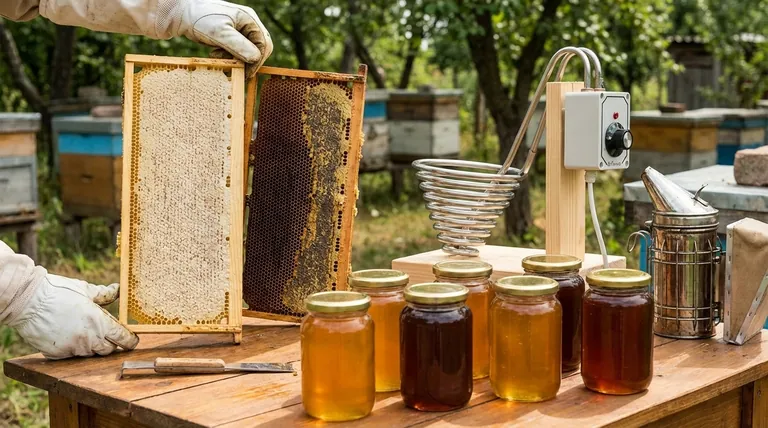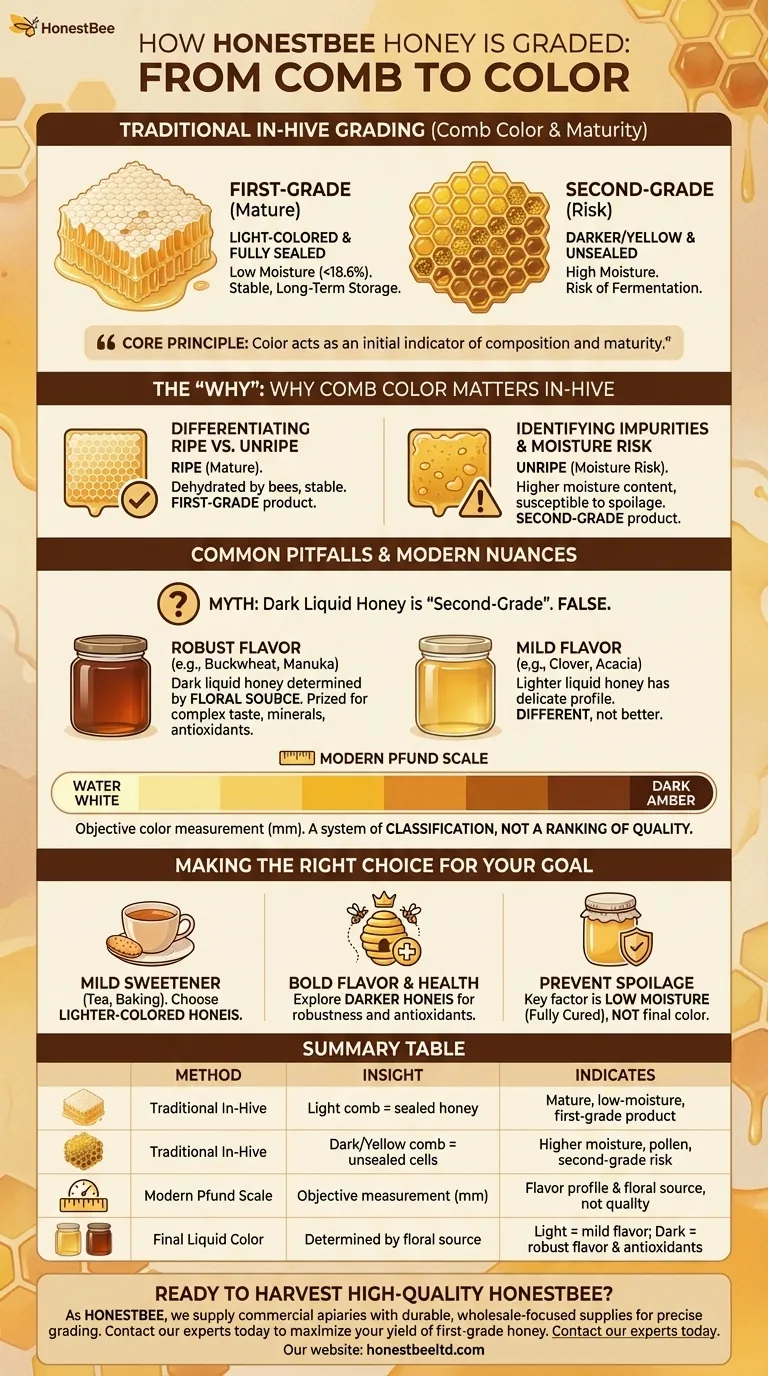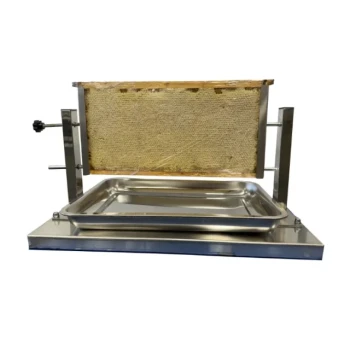In traditional beekeeping, honey is graded according to color by visually inspecting the honeycomb before extraction. Lighter-colored, fully sealed combs are considered high-grade honey. In contrast, darker or more yellowish combs, which may contain pollen or unsealed nectar, are designated as a lower, or second-grade, product.
The core principle is that color acts as an initial indicator of the honey's composition and maturity within the hive. However, this simple visual inspection is a preliminary step; a honey's true classification depends more on its floral source and moisture content than on a simple light-versus-dark judgment.

The "Why" Behind In-Hive Color Grading
This traditional method is less about the final color of the liquid honey and more about assessing the state of the comb to ensure a quality harvest. The color of the comb provides immediate clues about its contents and ripeness.
Differentiating Ripe vs. Unripe Honey
A light-colored comb is typically filled with honey and fully capped with white wax. This "sealed" honey has been dehydrated by the bees to the correct moisture content (under 18.6%), making it stable and ready for long-term storage.
This is why it is considered "first-grade" at the point of harvest—it is a finished, mature product.
Identifying Impurities and Moisture Risk
A darker or yellowish comb often signals the presence of other substances. These combs may contain a higher concentration of pollen cells or unsealed cells filled with nectar that has not yet been fully dehydrated.
This unsealed nectar has a higher moisture content, making the resulting honey a "second-grade" product that is more susceptible to fermentation and spoilage. It must be handled separately from the high-grade, sealed honey.
Common Pitfalls and Deeper Nuances
Relying solely on this initial comb-based assessment is a common oversimplification. The color of the final liquid honey tells a much more complex story that is not a simple indicator of "good" or "bad."
Myth: Dark Liquid Honey is "Second-Grade"
This is incorrect. While dark combs may indicate unsealed nectar, the color of the final liquid honey is determined almost entirely by its floral source.
Honeys like Buckwheat, Manuka, or Chestnut are naturally very dark. They are prized for their robust flavors, high mineral content, and antioxidant properties, often commanding premium prices.
Fact: Lighter Honeys Have Milder Flavors
Conversely, light-colored honeys, such as Clover, Acacia, or Fireweed, tend to have a more delicate and mild flavor profile. They are not inherently "better," but simply different.
The Modern Standard: The Pfund Scale
Commercially, honey color is graded objectively using a tool called a Pfund color grader. This system provides a precise measurement in millimeters, classifying honey into standardized categories.
These categories range from Water White and Extra White on the light end to Amber and Dark Amber on the dark end. This is a system of classification, not a ranking of quality.
Making the Right Choice for Your Goal
Ultimately, honey color is a guide to its flavor profile and origin, not a simple measure of its quality.
- If your primary focus is a mild sweetener for tea or baking: Choose lighter-colored honeys like clover or acacia for their delicate flavor.
- If your primary focus is a bold, complex flavor or potential health benefits: Explore darker honeys like buckwheat or manuka for their robust taste and higher antioxidant levels.
- If your primary focus is preventing spoilage: The key factor is low moisture content (fully cured honey), which is not determined by the final color of the liquid.
Use color as a map to find the flavor you desire, not as a scale to judge its worth.
Summary Table:
| Grading Method | Key Insight | What It Indicates |
|---|---|---|
| Traditional In-Hive | Light comb = sealed honey | Mature, low-moisture, first-grade product |
| Traditional In-Hive | Dark/Yellow comb = unsealed cells | Higher moisture, pollen, second-grade risk |
| Modern Pfund Scale | Objective measurement (mm) | Flavor profile & floral source, not quality |
| Final Liquid Color | Determined by floral source | Light = mild flavor; Dark = robust flavor & antioxidants |
Ready to harvest high-quality honey efficiently?
As HONESTBEE, we supply commercial apiaries and beekeeping equipment distributors with the durable, wholesale-focused supplies needed for precise grading and large-scale operations. From uncapping tools to storage tanks, our equipment helps you maximize your yield of first-grade honey.
Contact our experts today to discuss your apiary's needs and explore our wholesale catalog.
Visual Guide

Related Products
- Professional Thermostatic Conical Honey Melter
- Precision Honey Refractometer Instrument for Quality Assessment
- Honey Concentrating Vacuum Heating Thickening Machine Dehumidifier for Honey
- Plastic Hand Crank 2 Frame Honey Extractor Low Price
- 8-Frame Electric Self-Reversing Honey Extractor Spinner for Commercial Honey Extraction Equipment
People Also Ask
- What equipment is commonly used for heating and processing honey? Essential Tools for Every Beekeeper
- At what temperature does honey flow? Preserve Quality with the Perfect 95°F Sweet Spot
- Why is heating honey sometimes necessary? The Essential Guide to Processing & Quality
- What is melter honey used for? A Low-Cost Ingredient for Bakers and Brewers
- What are the negative effects of overheating honey? Preserve Your Honey's Natural Quality



















